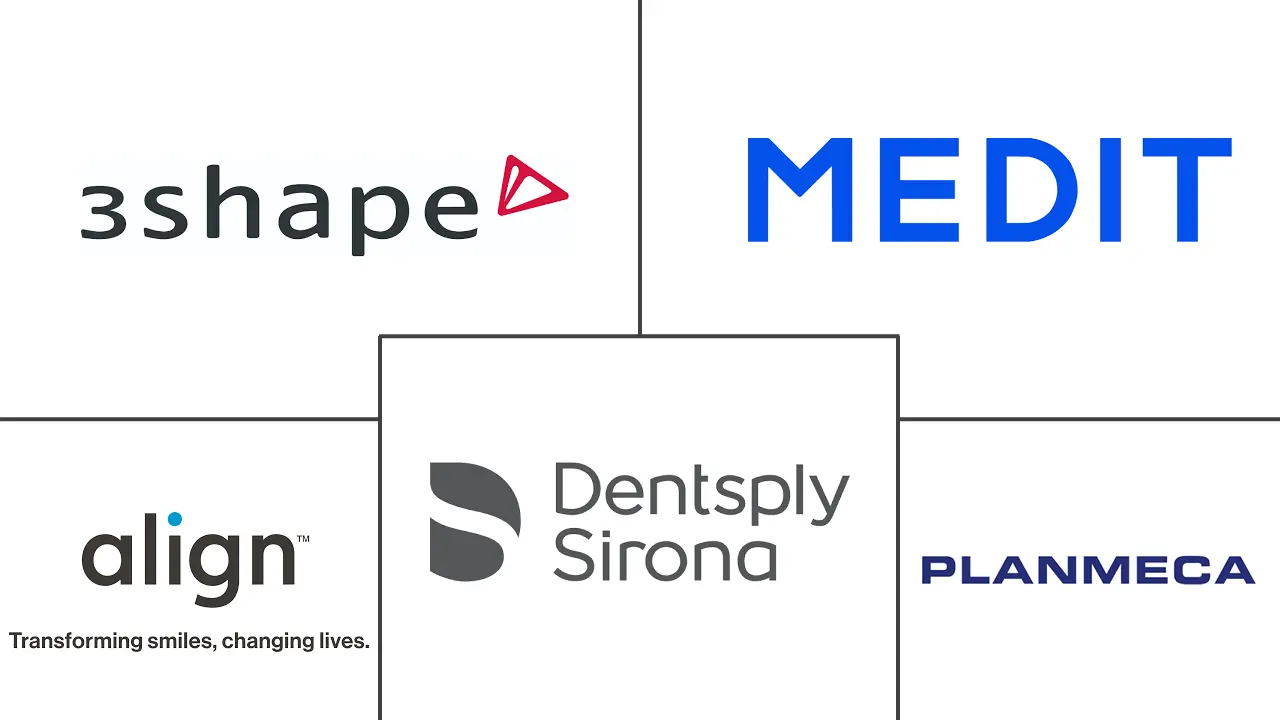Intraoral Scanners Market Size and Share
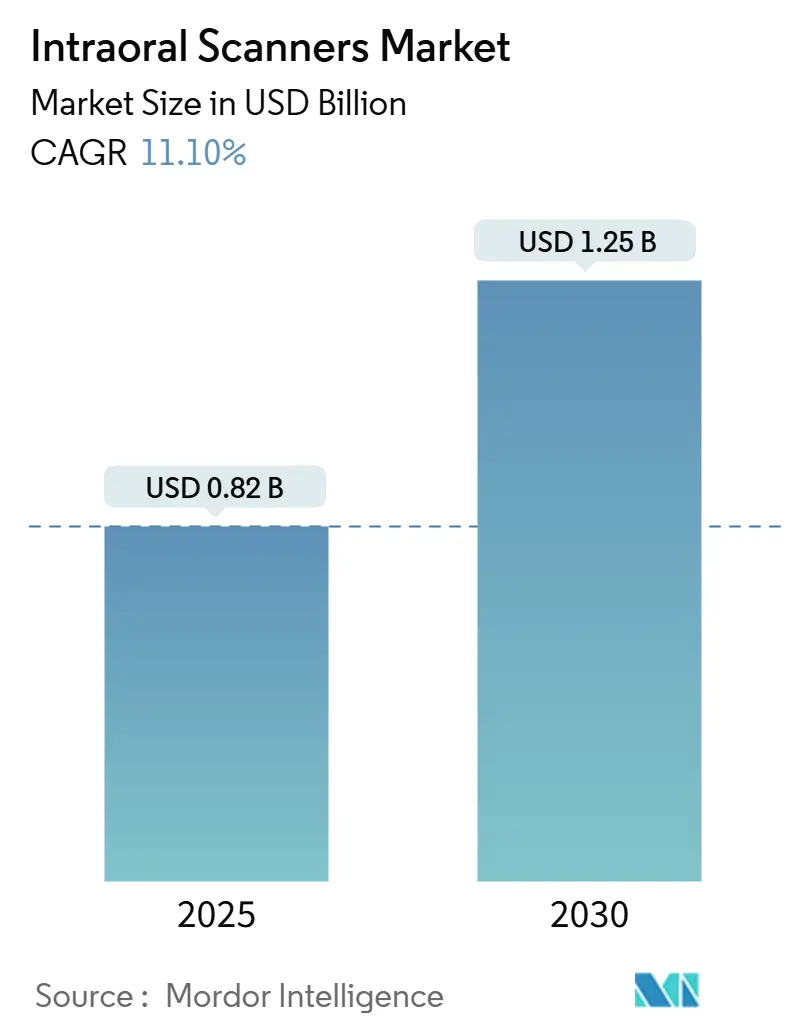
Intraoral Scanners Market Analysis by Mordor Intelligence
The intraoral scanners market stands at USD 0.82 billion in 2025 and is projected to advance to USD 1.25 billion by 2030, registering an 11.10% CAGR. The expansion is rooted in the global pivot toward digital dentistry, where chair-side imaging replaces alginate impressions, limits remakes, and accelerates restorative turnarounds. Growing restorative workloads linked to untreated caries, widespread patient demand for same-day crowns, and rapid progress in artificial-intelligence-driven image stitching are intensifying capital spending across both private clinics and hospital dentistry departments. Cost barriers are falling as Asian manufacturers introduce sub-USD 10,000 scanners, broadening access for emerging-economy practices and intensifying pricing pressure on premium incumbents. Simultaneously, government oral-health initiatives, updated ISO standards for optical coherence, and recent U.S. FDA clearances for wireless models signal greater regulatory confidence and expedite procurement decisions.
Key Report Takeaways
- By modality, stand-alone cart systems retained 60.0% of intraoral scanners market share in 2024; portable hand-held units are forecast to expand at a 13.0% CAGR through 2030.
- By type, powder-free scanners captured 85.0% of 2024 revenue and are poised to grow at an 11.0% CAGR between 2025 and 2030.
- By connectivity, wired units held 90.0% of the intraoral scanners market size in 2024, yet wireless models are projected to post the fastest 14.5% CAGR.
- By application, orthodontics led with 43.0% of 2024 revenue; implantology is set for a 14.3% CAGR to 2030.
- By end user, hospitals commanded 55.0% of 2024 revenue, while dental clinics are positioned for a 13.8% CAGR over the forecast horizon.
- By geography, North America generated 42.2% of 2024 revenue, but Asia-Pacific is expected to record the highest 12.8% CAGR through 2030.
Global Intraoral Scanners Market Trends and Insights
Drivers Impact Analysis
| Driver | (~) % Impact on CAGR Forecast | Geographic Relevance | Impact Timeline |
|---|---|---|---|
| Rising global dental-caries burden | +2.3% | Global | Long term (≥ 4 years) |
| Patient demand for same-day CAD/CAM restorations | +1.7% | North America, Europe | Medium term (2-4 years) |
| Clinic capital-equipment modernization | +1.6% | Asia-Pacific, Latin America | Medium term (2-4 years) |
| AI integration into scan workflows | +1.9% | Global | Long term (≥ 4 years) |
| Expansion of Dental Service Organizations (DSOs) creating scaled, standardized procurement | +1.5% | North America, Europe | Medium term (2-4 years) |
| Reimbursement inclusion for digital impressions | +1.4% | North America, Europe | Short term (≤ 2 years) |
| Source: Mordor Intelligence | |||
Rising Global Burden of Dental Caries & Tooth Loss
The World Health Organization identifies untreated dental caries as the most prevalent health condition worldwide, affecting more than 2 billion adults and 514 million children[1]World Health Organization, “Oral Health,” who.int. Heightened restorative needs push clinicians toward digital impressions that minimize gag reflex, shorten chair time, and deliver micron-level accuracy for indirect restorations. U.S. CDC surveillance confirms similar pressure at national level, with 46% of adults showing signs of untreated caries[2]Centers for Disease Control and Prevention, “Oral Health Conditions,” cdc.gov. These epidemiological realities sustain high procedure volumes and anchor long-run demand in the intraoral scanners market.
Growing Patient Demand for Same-Day Dentistry and Aesthetic Convenience
Same-visit crowns, inlays, and veneers are becoming a competitive differentiator. Public polling by the American Dental Association shows that 72% of U.S. patients would switch practitioners to obtain single-day restorations[3]American Dental Association, “Digital Dentistry Polling Data,” ada.org. In-office milling combined with instant scanning reduces laboratory turnarounds that previously stretched to two weeks. The resulting workflow efficiencies boost clinic revenue per chair and improve case acceptance, placing digital scanners at the heart of modern restorative care and supporting robust intraoral scanners market growth.
Accelerating Capital Expenditure on Clinic Modernization
The ASEAN Dental Council notes a 22% average annual increase in digital-equipment budgets among urban Southeast-Asian clinics, driven by government tax incentives for technology upgrades. Similar grant schemes are visible in the European Union’s Horizon Europe program, which provides subsidies for small practices adopting digital workflows. These fiscal accelerants help offset scanner acquisition costs and broaden adoption, particularly across emerging economies where cost sensitivity has historically curbed intraoral scanners market penetration.
Integration of Artificial Intelligence to Enhance Accuracy, Speed, and Automation
The U.S. FDA granted 510(k) clearance in 2024 for AI-embedded scan software that auto-detects marginal gaps and flags incomplete data sets, underscoring regulatory validation of smart algorithms. Parallel work by the European Committee for Standardization has advanced technical specifications for AI-supported intraoral optical systems, encouraging vendor alignment with forthcoming EN ISO norms. AI therefore undergirds higher throughput, smoother learning curves, and enriched diagnostics, further boosting the intraoral scanners market.
Restraints Impact Analysis
| Restraint | (~) % Impact on CAGR Forecast | Geographic Relevance | Impact Timeline |
|---|---|---|---|
| Lack of universal file-format standards | –1.8% | Global | Medium term (2-4 years) |
| Steep learning curve and continuous training requirements | –1.5% | Global | Short term (≤ 2 years) |
| Regulatory approval delays and varied compliance requirements slowing new scanner launches in emerging regions | –1.6% | Asia-Pacific, Latin America | Medium term (2-4 years) |
| High up-front acquisition cost versus traditional impression materials, especially for small practices | –1.9% | Global | Short term (≤ 2 years) |
| Source: Mordor Intelligence | |||
Lack of Universal File-Format Standards
Absence of a truly open digital-impression standard forces clinics working with multi-brand CAD/CAM chains to juggle proprietary formats, imposing extra conversion steps and elongating delivery timelines. The International Organization for Standardization has yet to finalize the proposed ISO 20898 open-scan file schema, leaving interoperability a work in progress[4] International Organization for Standardization, “ISO 20898 Draft,” iso.org. Until adoption crystallizes, fragmented ecosystems will persist, limiting seamless data exchange and tempering the pace of intraoral scanners market adoption.
Steep Learning Curve and Ongoing Training Needs
Research from the U.K.’s National Health Service Digital Dentistry Taskforce shows that initial scan appointments for novices average 8 minutes compared with 5 minutes for experienced users, representing a 38% efficiency gap that can deter first-time buyers. Staff upskilling hours and possible chair-time penalties therefore constitute hidden costs, especially for small practices. Vendors are countering with embedded tutorial modes and video-guided prompts, yet the training burden remains a measurable restraint on the intraoral scanners market.
Segment Analysis
By Modality: Portability Reshaping Clinical Workflows
Stand-alone carts formed 60.0% of 2024 revenue, giving the segment the largest slice of intraoral scanners market size. Their 19-inch touch displays and integrated GPUs improve margin review, making them indispensable for full-arch reconstructions in high-volume settings. Government-funded teaching hospitals in Germany and South Korea frequently adopt carts because equipment stays in shared digital labs, simplifying asset tracking.
Portable hand-held scanners, however, are forecast to outpace carts at a 13.0% CAGR through 2030. Lightweight designs under 280 g and hot-swappable battery packs allow seamless movement across operatories, an advantage for five-chair polyclinics common in Brazil’s public-health system. Early evaluations by the National Institute of Dental and Craniofacial Research found no statistical difference in quadrant accuracy between cart and portable units, supporting wider deployment in community settings. As wireless data transfer matures under Wi-Fi 6E protocols, the portable share of the intraoral scanners market is likely to expand substantially.
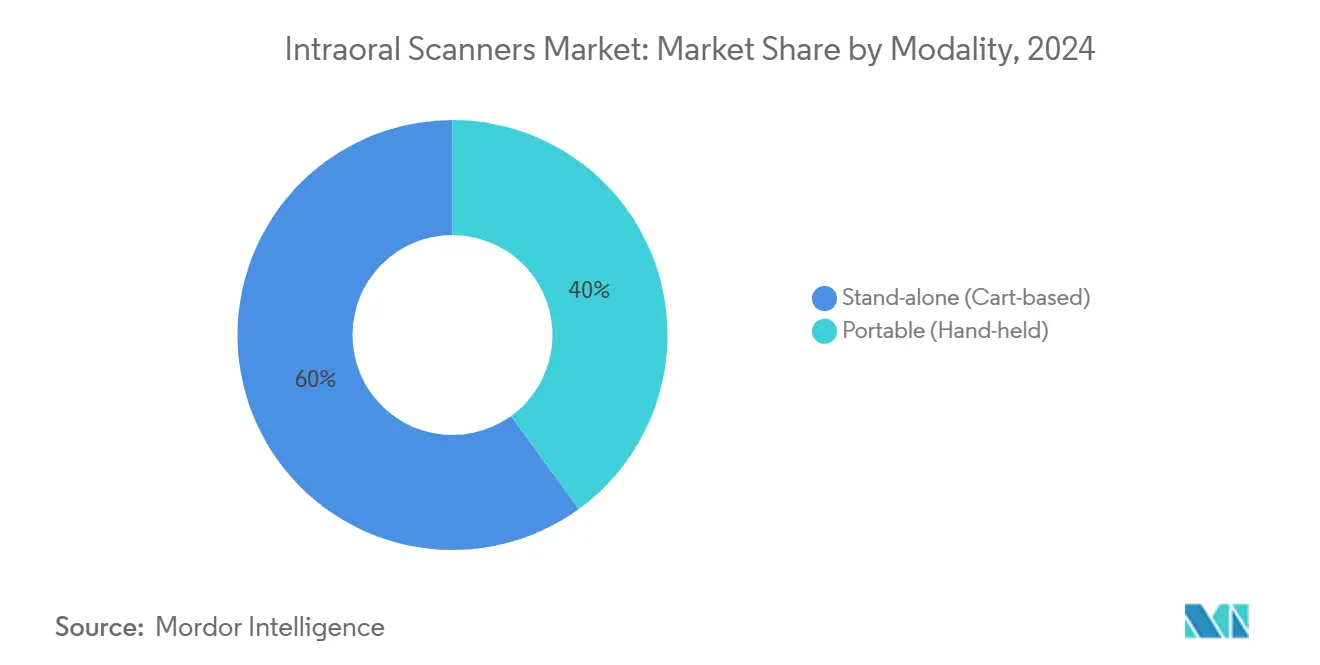
By Type: Powder-Free Technology Dominates Clinical Adoption
Powder-free scanners controlled 85.0% of revenue in 2024, thanks to optics that handle glossy enamel without titanium-oxide sprays. The approach eliminates inhalation risks flagged by the U.S. Occupational Safety and Health Administration and shortens procedural steps. Yet, scanned translucency on zirconia veneers can suffer under intense operatory lighting. A German Institute for Standardization round-robin test recorded average surface deviation of 40 µm on highly translucent restorations when powder-free images were used, compared with 25 µm for light-powdered surfaces. Vendors are rapidly enhancing multi-wavelength LED arrays and polarizing filters to bridge gaps, indicating powder-free will retain dominant intraoral scanners market share.
By Connectivity: Wireless Freedom Gaining Traction
Wired units represented 90.0% of the intraoral scanners market size in 2024, favored for consistent bandwidth and zero battery anxiety. Their instantaneous USB-C link reduces latency in practices processing 40 scans per day, a threshold typical in U.S. dental-service organizations.
Wireless devices, however, are projected to grow at a 14.5% CAGR as Bluetooth 5.3 and edge-computing chips overcome prior frame-drop issues. The Australian Therapeutic Goods Administration cleared the nation’s first lithium-battery-powered scanner in 2024, validating safety profiles under IEC 62133. Cloud handshakes via encrypted APIs also enable real-time uploads to laboratories that comply with HIPAA and GDPR, making wireless attractive in cross-border dental tourism hubs and lifting overall momentum inside the intraoral scanners market.
By Application: Orthodontics Leads Digital Transformation
Orthodontics contributed 43.0% of 2024 revenue, underpinning the largest segment of the intraoral scanners market. Real-time arch simulations improve patient comprehension and expedite informed consent. Guidelines released by the American Association of Orthodontists in 2024 recommend intraoral scanning for all aligner therapy case submissions to reduce shipping-related deformation.
Implantology is expected to outpace every other indication, with a forecast 14.3% CAGR through 2030. The International Team for Implantology reports that intraoral scanners now deliver sub-30 µm trueness on edentulous pilot scans when smart stitching and reference markers are used. Such precision supports immediate-load protocols and undergirds growth in this branch of the intraoral scanners market.
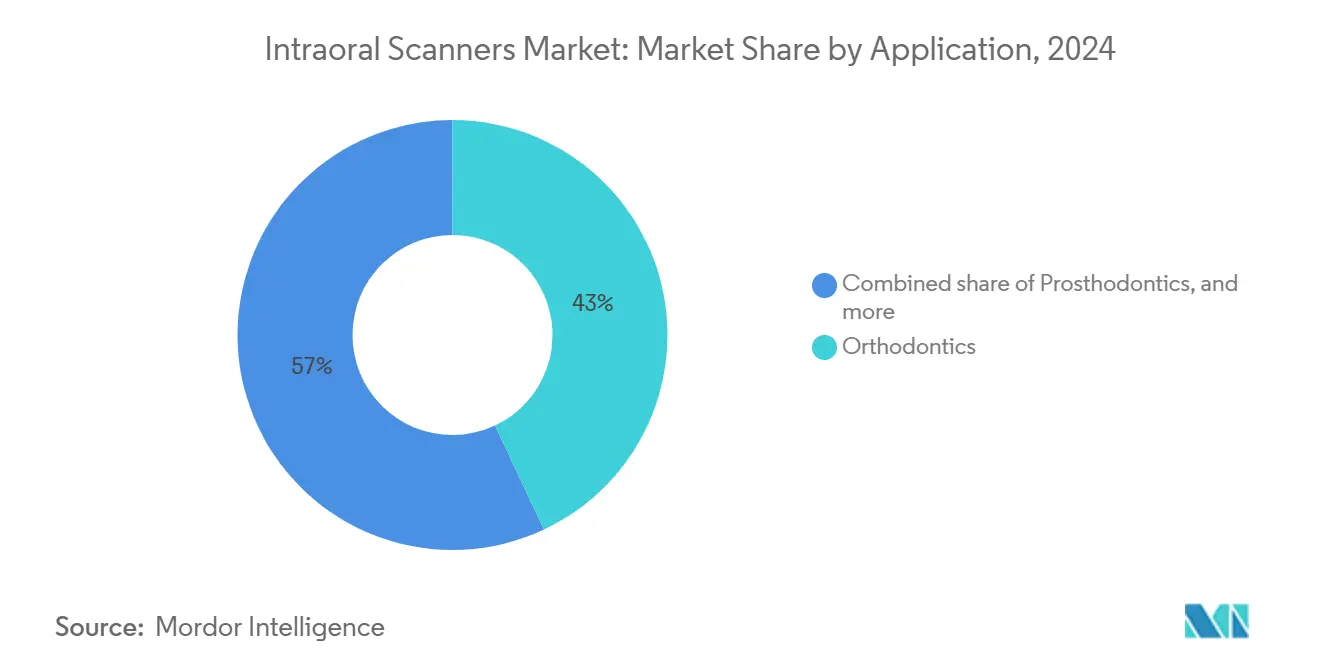
By End User: Hospital–Clinic Dynamics Reshaping Adoption
Hospitals garnered 55.0% of global revenue in 2024, leveraging consolidated capital budgets and compatibility with picture-archiving systems used in maxillofacial surgery. University dental schools in Canada and Japan acquire high-end carts to expose students to digital workflows, reinforcing institutional weight inside the intraoral scanners market.
Independent clinics, however, are projected to show a 13.8% CAGR. The Pan-European Federation of Dental Laboratories notes that 67% of suburban practices under five chairs expect to buy a scanner by 2027, citing faster insurance processing under e-health portals. Subscription-based scanner leases that bundle software upgrades lower upfront cash requirements, widening the customer base and reshaping revenue distribution across the intraoral scanners market.
Geography Analysis
North America remained the single largest geography with 42.2% of 2024 revenue. U.S. clinical adoption is further propelled by tax deductibility under Section 179 for digital capital equipment, effectively reducing scanner acquisition costs by up to 35% for small businesses. The Canadian Dental Association likewise publishes national e-health frameworks that encourage cloud storage, supporting advanced workflows and sustaining the intraoral scanners market.
Asia-Pacific is the fastest-growing region, slated for a 12.8% CAGR through 2030. China added more than 10,000 new private dental clinics in 2024, many of which participate in municipal subsidies for digital imaging upgrades under the Healthy China 2030 blueprint. India’s National Oral Health Program released training modules on digital impression techniques to improve rural outreach and reduce chair time, indirectly lifting scanner demand. Regional manufacturing clusters in Shenzhen and Seoul now offer scanners that conform to IEC 60601 safety standards at one-third the price of Western equivalents, accelerating intraoral scanners market diffusion.
Europe holds a substantial share fostered by robust insurance coverage and stringent data-privacy protections. Germany’s Federal Joint Committee now reimburses digital impressions for indirect restorations under the statutory health insurance system, reducing out-of-pocket patient costs. The U.K. National Health Service is piloting intraoral scanners in community clinics to cut turnaround times for dentures, aiming to meet access targets under its dental recovery plan. GDPR compliance drives high demand for cloud solutions hosting servers within the European Economic Area, shaping purchasing criteria and reinforcing the intraoral scanners market’s distinct regional dynamics.
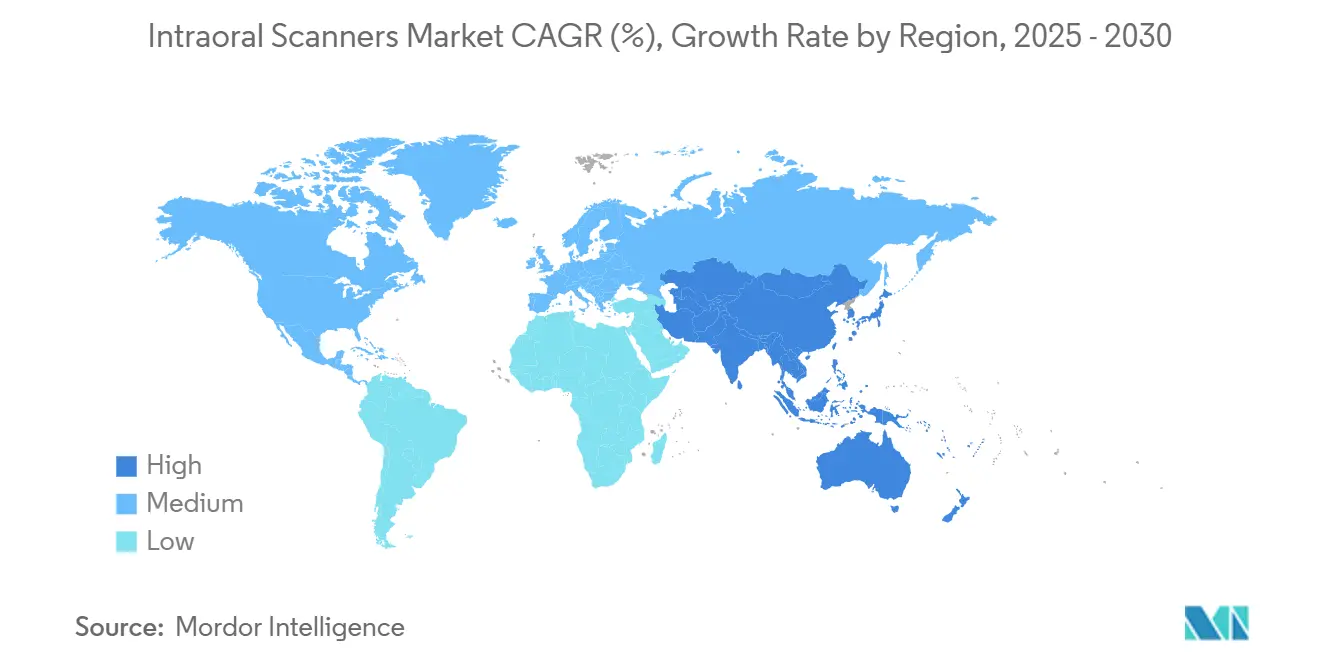
Competitive Landscape
The intraoral scanners market shows moderate concentration: the top three vendors hold roughly 60.0% of global revenue. Leading suppliers differentiate through AI-driven software ecosystems, regulatory clearances, and turnkey CAD/CAM workflows. Align Technology’s portfolio now includes a U.S. FDA-cleared AI module that auto-detects interproximal caries, offering added clinical value without extra chair time. Dentsply Sirona focuses on cloud-native interoperability, hosting anonymized patient files on European-based servers that comply with GDPR and ISO/IEC 27001.
Simultaneously, cost-disruptive Asian entrants supported by Chinese National Medical Products Administration class II approvals are penetrating Latin-American and Middle-Eastern markets at aggressive price points. To counter, incumbents are launching tiered product lines, extended-life warranties, and collaboration protocols with third-party labs certified under EN ISO 13485, widening their service moat inside the intraoral scanners market. Interoperability alliances, such as recent cross-licensing deals that let 3Shape software drive Dentsply milling units, underscore a strategic shift toward ecosystem openness.
Government procurement trends also mold competitive footing. The U.S. Veterans Health Administration recently initiated a multiyear purchase plan for wireless scanners across 150 dental clinics, stipulating compliance with FIPS 140-3 encryption and NIST SP 800-53 cybersecurity standards. Vendors meeting those federal clauses gain a durable revenue stream and a credibility lift that cascades into private-sector demand, reinforcing leadership positions in the intraoral scanners market.
Intraoral Scanners Industry Leaders
-
3Shape A/S
-
Align Technology, Inc.
-
Dentsply Sirona Inc.
-
Planmeca Oy
-
MEDIT Corp.
- *Disclaimer: Major Players sorted in no particular order
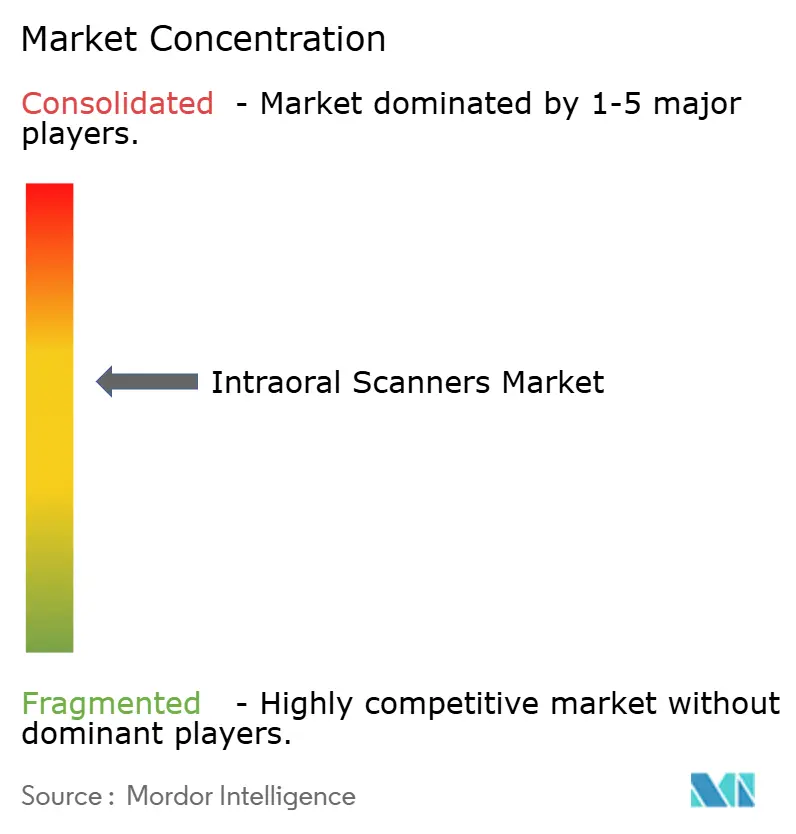
Recent Industry Developments
- February 2025: U.S. FDA cleared a next-generation wireless intraoral scanner incorporating AI-guided margin detection, the first such system authorized under the agency’s new Medical Device Development Tools program
- February 2025: The U.S. Department of Veterans Affairs issued a USD 22 million procurement notice for cloud-native scanners to modernize its nationwide dental clinics
- March 2024: The European Medicines Agency highlighted digital impression systems in its annual dental-device vigilance report, citing fewer adverse events compared with traditional tray impressions
- October 2024: Health Canada published guidance on cybersecurity requirements for intraoral scanners, aligning the Medical Devices Regulations with ISO/IEC 81001-1
- September 2024: The Australian Dental Association released best-practice recommendations for integrating wireless scanners into infection-control protocols, emphasizing battery-surface disinfection and barrier sleeves
Research Methodology Framework and Report Scope
Market Definitions and Key Coverage
Our study defines the intraoral scanners market as all new, factory-built digital devices that capture three-dimensional images of teeth and gingival tissues inside the mouth, streaming these data to CAD/CAM or cloud platforms for diagnosis and restorative workflows. According to Mordor Intelligence, values are reported in USD at the manufacturer selling price level and cover stand-alone cart systems as well as portable hand-held units that operate on optical or confocal imaging.
Scope Exclusion: The sizing excludes intraoral cameras, radiographic sensors, impression materials, and any refurbished or rental scanners.
Segmentation Overview
- By Modality
- Stand-alone (Cart-based)
- Portable (Hand-held)
- By Type
- Powder-Free
- Powder-Based
- By Connectivity
- Wired
- Wireless
- By Application
- Orthodontics
- Prosthodontics
- Implantology
- Other Applications
- By End User
- Dental Clinics
- Hospitals
- Other End Users
- Geography
- North America
- United States
- Canada
- Mexico
- Europe
- Germany
- United Kingdom
- France
- Italy
- Spain
- Rest of Europe
- Asia-Pacific
- China
- Japan
- India
- South Korea
- Australia
- Rest of Asia-Pacific
- Middle-East and Africa
- GCC
- South Africa
- Rest of Middle East and Africa
- South America
- Brazil
- Argentina
- Rest of South America
- North America
Detailed Research Methodology and Data Validation
Primary Research
Mordor analysts interviewed practicing dentists, dental-lab managers, regional distributors, and product trainers across North America, Europe, and Asia-Pacific. These conversations validated unit penetration, learning-curve barriers, and true ASP erosion that secondary sources only hint at.
Desk Research
We first built a knowledge base from open, authoritative sources such as the US Centers for Medicare & Medicaid Services, Eurostat trade codes for "dental instruments," national dental association fee surveys, and patent analytics from Questel. Industry journals, FDA 510(k) filings, and company 10-Ks helped us benchmark shipments, average selling prices, and replacement cycles. Supplementary insights were accessed through D&B Hoovers and Dow Jones Factiva for financial signals. The sources listed illustrate, not exhaust, the wide set consulted by Mordor analysts; many more aided data checks and clarification.
Market-Sizing & Forecasting
Top-down reconstruction began with yearly production and import-export records for scanners, which were then adjusted for average distributor mark-ups to reach end-market value. Bottom-up cross-checks sampled supplier roll-ups and channel checks tightened totals. Key variables modeled include chairside CAD/CAM adoption, scanner replacement interval, orthodontic case volumes, per-capita dental expenditure, and regulatory approvals. A multivariate regression blended with scenario analysis projects each variable through 2030; anomalies are reconciled through expert re-contact before figures lock.
Data Validation & Update Cycle
Outputs pass a multi-step review that flags variance versus independent trade data and prior editions. Reports refresh yearly, with interim updates triggered by material events such as major product launches or reimbursement changes, ensuring buyers always receive our latest view.
Why Our Intraoral Scanners Baseline Commands Reliability
Published estimates often diverge because firms choose different device mixes, price assumptions, and refresh cadences.
Key gap drivers include varying inclusion of accessories, use of end-user versus manufacturer pricing, differing CAGR assumptions for replacement demand, and the fact that Mordor updates its model annually while some peers carry older benchmarks.
Benchmark comparison
| Market Size | Anonymized source | Primary gap driver |
|---|---|---|
| USD 820 million (2025) | Mordor Intelligence | - |
| USD 600 million (2023) | Global Consultancy A | Uses 2023 base year and excludes portable systems |
| USD 641 million (2025) | Industry Platform B | Applies clinic purchase prices without deducting dealer margins |
| USD 708 million (2024) | Trade Journal C | Forecast based on scanner shipments only, omits software licensing revenue |
These contrasts show that Mordor's disciplined scope definition, dual-track modeling, and quicker refresh cadence deliver the balanced, transparent baseline decision-makers can depend on.
Key Questions Answered in the Report
What is the current size of the intraoral scanners market?
The market is valued at USD 0.82 billion in 2025 and is expected to reach USD 1.25 billion by 2030, reflecting an 11.10% CAGR.
Which modality segment is growing fastest?
Portable hand-held scanners are projected to grow at a 13% CAGR through 2030 as lighter wands and wireless data links gain favor.
How does artificial intelligence improve scanning workflows?
AI algorithms auto-trim excess tissue, highlight missed areas, and detect early caries, reducing retake rates and enhancing diagnostic value.
What is the main interoperability barrier?
The absence of a universal open file standard forces multi-brand clinics to rely on proprietary formats, creating conversion steps and bottlenecks.
Why is Asia-Pacific the fastest-growing region?
Rapid clinic expansion, government subsidies for digital equipment, and locally manufactured low-cost scanners drive a 12.8% CAGR outlook.
How concentrated is the competitive landscape?
The top three vendors control roughly 60% of revenue, indicating moderate concentration yet allowing room for emerging manufacturers to gain share.
Page last updated on:
